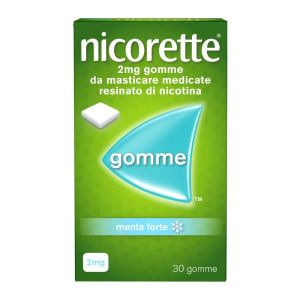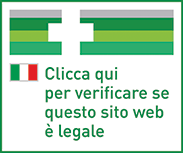Ship in Europe, Find out rates!
Language
Nicorette Gums 2mg Nicotine Mint 30 Chewable Gummies

Regular Price
€22.79
Special Price
€17.73
-22%
Save: €5.06
In stock
Recent lowest price:
€17.73
- box Delivery in Italy in 24/48 and free returns
- star3.000+ positive reviews
- dropboxOver 60,000 products in the catalog
Manufacturer
JOHNSON & JOHNSON
SKU
025747736
Active principle
NICOTINA
NAME
NICORETTE CHEWING GUMS MEDICATED
PHARMACOTHERAPEUTIC CATEGORY
Drugs used in addictive disorders.
ACTIVE PRINCIPLES
Medicated chewing gum 2 mg: nicotine resin complex 10 mg, containing 20% nicotine, corresponding to 2 mg of nicotine. 4 mg medicated chewing gum: 20 mg nicotine resin complex, containing 20% nicotine, corresponding to 4 mg nicotine.
EXCIPIENTS
>> Medicated gum 2 mg: anhydrous sodium carbonate, sodium bicarbonate, chewing gum base, sorbitol powder, 70% sorbitol solution, mint and fruit flavors, 85% glycerin solution. >> Medicated gum 4 mg: anhydrous sodium carbonate, chewing gum base, sorbitol powder, 70% sorbitol solution, mint and fruit flavors, glycerin 85% solution, quinoline yellow (E 104). >> Mint flavored medicated gum 2 mg: anhydrous sodium carbonate, sodium bicarbonate, chewing gum base, xylitol, mint essence, levomenthol, magnesium oxide. >> Mint flavored medicated gum 4 mg: anhydrous sodium carbonate, chewing gum base, xylitol, mint essence, levomenthol, magnesium oxide, yellowquinoline (E 104). >> Medicated gum fresh mint flavor 2 mg: base chewing gum, xylitol, mint essence, sodium carbonate, sodium bicarbonate, acesulfame potassium, levomenthol, magnesium oxide, acacia, titanium dioxide, carnauba wax. >> Medicated gum fresh mint flavor 4 mg: chewing gum base, xylitol, mint essence, sodium carbonate, acesulfame potassium, levomentol, magnesium oxide, acacia, titanium dioxide, carnauba wax, quinoline yellow (E 104). >> Tuttifrutti medicated gum 2 mg: chewing gum base, xylitol, tuttifrutti essence, sodium carbonate, sodium bicarbonate, acesulfame potassium, levomenthol, hypromellose, sucralose polysorbate 80, magnesium oxide, acacia, titanium dioxide, carnauba wax. >> Tuttifrutti flavor medicated gum 4 mg: chewing gum base, xylitol, tuttifrutti essence, sodium carbonate, acesulfame potassium, levomenthol, hypromellose, sucralose polysorbate 80, magnesium oxide, acacia, titanium dioxide, carnauba wax, quinoline yellow ( E 104). >> Gommemedicate strong mint flavor 2 mg: chewing gum base, xylitol, peppermint oil, acesulfame potassium, sodium carbonate, sodium bicarbonate, levomenthol, magnesium oxide, pregelatinised starch, titanium dioxide, carnauba wax, hypromellose, sucralose, polysorbate 80, glacial mint. >> Medicated gum mint flavor 4 mg: chewing gum base, xylitol, peppermint oil, acesulfame potassium, sodium carbonate, levomentol, magnesium oxide, pregelatinised starch, titanium dioxide, carnauba wax, quinoline yellow (E 104), hypromellose, sucralose, polysorbate 80, glacial mint.
INDICATIONS
Treatment for smoking cessation.
CONTRAINDICATIONS / SECONDARY EFFECT
Do not administer to non-smokers or to patients with known hypersensitivity to nicotine. In case of recent myocardial infarction; unstable or aggravated angina pectoris; Prinzmetal's angina; severe cardiac arrhythmia; acute stroke.
DOSAGE
Children and adolescents: do not administer to people under the age of 18 without medical advice. Adults and the elderly: the dosage depends on the quantity of cigarettes normally consumed by the individual smoker. It is advisable to start with the 2 mg preparation identifying, according to the need for the optimal dosage, the number of chewing gums during the day. If 15 2 mg gums per day are not sufficient, as for example in heavy smokers (more than 20 cigarettes a day) it is preferable to use 4 mg chewable gums, or two 2 mg gums at the same time. Chew a piece of gum whenever you feel the need to smoke. It is important to CHEW VERY SLOWLY FOR AT LEAST 30 MINUTES to get the nicotine released. Chewing too fast causes the absorption of nicotine in too short a time: to avoid this inconvenience it is advisable to stop chewing from time to time. Do not use more than 15 4 mg gums per day. The recommended duration of treatment is 3 months. After this period the daily dose should be gradually reduced. When this has dropped to 1-2 tires, it is recommended that you try to stop using it completely. However, it is advisable to have some spare chewing gum available in case of a sudden return of the desire to smoke. The product is also easy to handle for diabetics because it does not contain sucrose or glucose. It is not advisable to extend the treatment beyond 12 months. The number of gums used must be sufficient to cover the nicotine requirement. For most smokers, 10 x 2 mg gums per day are usually sufficient.
STORAGE
Store below 25 degrees C.
WARNINGS
The cardiovascular effects of nicotine could be risky in patients with severe cardiovascular disease (peripheral arterial occlusive disease, cerebrovascular disease, unstable angina pectoris, and heart failure), vasospasm, uncontrolled hypertension, severe hepatic and / or renal insufficiency, active duodenal and gastric ulcers. Use with caution and under close medical supervision by patients with diabetes mellitus, hyperthyroidism or pheochromocytoma, since nicotine causes the release of catecholamines from the adrenal glands. However, the use is less risky than smoking. The product should be kept out of the reach of children, similar to cigarettes, cigars and tobacco. Smokers with dental prostheses may find it difficult to chew gum: the special formulation of the chewing gum minimizes this inconvenience. Smoking and concomitant use of nicotine replacement therapy (NRT): When nicotine replacement therapy products are used to reduce smoking, nicotine released from cigarettes is also present in the body. It is unclear whether nicotine released from cigarettes affects the elimination of nicotine provided by replacement therapy products or vice versa. Although nicotine has been reported to be eliminated more rapidly by smokers than by non-smokers, suggesting that nicotine itself promotes their own elimination, a more thorough study has shown that the reverse is also true. Another study found that cotinine, the major metabolite of nicotine produced by smoking, did not increase or decrease the elimination of nicotine. In a more direct test, conducted on the same subjects, the elimination of nicotine administered intravenously is was 36% slower during a short period of smoking than a short period of abstinence. The product contains sodium salts: use with caution in subjects following low-sodium diets. Chewing gums without mint contain sorbitol: use with caution in cases of hereditary fructose intolerance; can cause stomach problems and diarrhea.
INTERACTIONS
Smoking is associated with an increase in CYP1A2 enzyme activity. After smoking cessation, a reduction in the clearance of substrates of this enzyme may occur. This may lead to an increase in plasma levels of some medicinal products of clinical importance for those drugs with a narrow therapeutic index such as theophylline, tacrine and clozapine. Smoking cessation may also increase the concentration of other drugs partially metabolised by the CYP1A2 enzyme, such as imipramine, olanzapine, clomipramine and fluvoxamine, although data are scarce and possible clinical significance unknown. Limited data also indicate that smoking can induce the metabolism of flecainide and pentazocine.
SIDE EFFECTS
The most frequently reported undesirable effects in clinical trials are similar to those that may occur when smoking and may be caused by excessive use compared to the usual amount of cigarettes. These effects may include: cough, headache, mouth and throat irritation, congestion, nasal, ulcerative sores, sore throat, anxiety, depression, malaise, vomiting, dry mouth, heartburn, joint pain, diarrhea, bloating , allergy, shortness of breath, feeling thirsty and hiccups. Some symptoms, such as dizziness, headache and insomnia, may be related to the withdrawal symptoms associated with stopping smoking and may also occur if Nicorette is used insufficiently.
PREGNANCY AND BREASTFEEDING
Pregnancy: only in the event that the pregnant woman continues to smoke, the use of the drug may be justified, the use of which may involve potential risks. Nicotine reaches the fetus and affects its cardiorespiratory system. The effect is dose dependent. Therefore, pregnant women smokers are advised to quit smoking completely without undertaking nicotine replacement therapy. The risk of continuing to smoke could cause greater harm to the fetus than using a nicotine replacement therapy according to a controlled smoking cessation program. Breastfeeding: nicotine passes freely into breast milk in quantities that can have harmful effects on the infant. This also occurs with the use of drugs containing nicotine, at the recommended therapeutic doses.
NICORETTE CHEWING GUMS MEDICATED
PHARMACOTHERAPEUTIC CATEGORY
Drugs used in addictive disorders.
ACTIVE PRINCIPLES
Medicated chewing gum 2 mg: nicotine resin complex 10 mg, containing 20% nicotine, corresponding to 2 mg of nicotine. 4 mg medicated chewing gum: 20 mg nicotine resin complex, containing 20% nicotine, corresponding to 4 mg nicotine.
EXCIPIENTS
>> Medicated gum 2 mg: anhydrous sodium carbonate, sodium bicarbonate, chewing gum base, sorbitol powder, 70% sorbitol solution, mint and fruit flavors, 85% glycerin solution. >> Medicated gum 4 mg: anhydrous sodium carbonate, chewing gum base, sorbitol powder, 70% sorbitol solution, mint and fruit flavors, glycerin 85% solution, quinoline yellow (E 104). >> Mint flavored medicated gum 2 mg: anhydrous sodium carbonate, sodium bicarbonate, chewing gum base, xylitol, mint essence, levomenthol, magnesium oxide. >> Mint flavored medicated gum 4 mg: anhydrous sodium carbonate, chewing gum base, xylitol, mint essence, levomenthol, magnesium oxide, yellowquinoline (E 104). >> Medicated gum fresh mint flavor 2 mg: base chewing gum, xylitol, mint essence, sodium carbonate, sodium bicarbonate, acesulfame potassium, levomenthol, magnesium oxide, acacia, titanium dioxide, carnauba wax. >> Medicated gum fresh mint flavor 4 mg: chewing gum base, xylitol, mint essence, sodium carbonate, acesulfame potassium, levomentol, magnesium oxide, acacia, titanium dioxide, carnauba wax, quinoline yellow (E 104). >> Tuttifrutti medicated gum 2 mg: chewing gum base, xylitol, tuttifrutti essence, sodium carbonate, sodium bicarbonate, acesulfame potassium, levomenthol, hypromellose, sucralose polysorbate 80, magnesium oxide, acacia, titanium dioxide, carnauba wax. >> Tuttifrutti flavor medicated gum 4 mg: chewing gum base, xylitol, tuttifrutti essence, sodium carbonate, acesulfame potassium, levomenthol, hypromellose, sucralose polysorbate 80, magnesium oxide, acacia, titanium dioxide, carnauba wax, quinoline yellow ( E 104). >> Gommemedicate strong mint flavor 2 mg: chewing gum base, xylitol, peppermint oil, acesulfame potassium, sodium carbonate, sodium bicarbonate, levomenthol, magnesium oxide, pregelatinised starch, titanium dioxide, carnauba wax, hypromellose, sucralose, polysorbate 80, glacial mint. >> Medicated gum mint flavor 4 mg: chewing gum base, xylitol, peppermint oil, acesulfame potassium, sodium carbonate, levomentol, magnesium oxide, pregelatinised starch, titanium dioxide, carnauba wax, quinoline yellow (E 104), hypromellose, sucralose, polysorbate 80, glacial mint.
INDICATIONS
Treatment for smoking cessation.
CONTRAINDICATIONS / SECONDARY EFFECT
Do not administer to non-smokers or to patients with known hypersensitivity to nicotine. In case of recent myocardial infarction; unstable or aggravated angina pectoris; Prinzmetal's angina; severe cardiac arrhythmia; acute stroke.
DOSAGE
Children and adolescents: do not administer to people under the age of 18 without medical advice. Adults and the elderly: the dosage depends on the quantity of cigarettes normally consumed by the individual smoker. It is advisable to start with the 2 mg preparation identifying, according to the need for the optimal dosage, the number of chewing gums during the day. If 15 2 mg gums per day are not sufficient, as for example in heavy smokers (more than 20 cigarettes a day) it is preferable to use 4 mg chewable gums, or two 2 mg gums at the same time. Chew a piece of gum whenever you feel the need to smoke. It is important to CHEW VERY SLOWLY FOR AT LEAST 30 MINUTES to get the nicotine released. Chewing too fast causes the absorption of nicotine in too short a time: to avoid this inconvenience it is advisable to stop chewing from time to time. Do not use more than 15 4 mg gums per day. The recommended duration of treatment is 3 months. After this period the daily dose should be gradually reduced. When this has dropped to 1-2 tires, it is recommended that you try to stop using it completely. However, it is advisable to have some spare chewing gum available in case of a sudden return of the desire to smoke. The product is also easy to handle for diabetics because it does not contain sucrose or glucose. It is not advisable to extend the treatment beyond 12 months. The number of gums used must be sufficient to cover the nicotine requirement. For most smokers, 10 x 2 mg gums per day are usually sufficient.
STORAGE
Store below 25 degrees C.
WARNINGS
The cardiovascular effects of nicotine could be risky in patients with severe cardiovascular disease (peripheral arterial occlusive disease, cerebrovascular disease, unstable angina pectoris, and heart failure), vasospasm, uncontrolled hypertension, severe hepatic and / or renal insufficiency, active duodenal and gastric ulcers. Use with caution and under close medical supervision by patients with diabetes mellitus, hyperthyroidism or pheochromocytoma, since nicotine causes the release of catecholamines from the adrenal glands. However, the use is less risky than smoking. The product should be kept out of the reach of children, similar to cigarettes, cigars and tobacco. Smokers with dental prostheses may find it difficult to chew gum: the special formulation of the chewing gum minimizes this inconvenience. Smoking and concomitant use of nicotine replacement therapy (NRT): When nicotine replacement therapy products are used to reduce smoking, nicotine released from cigarettes is also present in the body. It is unclear whether nicotine released from cigarettes affects the elimination of nicotine provided by replacement therapy products or vice versa. Although nicotine has been reported to be eliminated more rapidly by smokers than by non-smokers, suggesting that nicotine itself promotes their own elimination, a more thorough study has shown that the reverse is also true. Another study found that cotinine, the major metabolite of nicotine produced by smoking, did not increase or decrease the elimination of nicotine. In a more direct test, conducted on the same subjects, the elimination of nicotine administered intravenously is was 36% slower during a short period of smoking than a short period of abstinence. The product contains sodium salts: use with caution in subjects following low-sodium diets. Chewing gums without mint contain sorbitol: use with caution in cases of hereditary fructose intolerance; can cause stomach problems and diarrhea.
INTERACTIONS
Smoking is associated with an increase in CYP1A2 enzyme activity. After smoking cessation, a reduction in the clearance of substrates of this enzyme may occur. This may lead to an increase in plasma levels of some medicinal products of clinical importance for those drugs with a narrow therapeutic index such as theophylline, tacrine and clozapine. Smoking cessation may also increase the concentration of other drugs partially metabolised by the CYP1A2 enzyme, such as imipramine, olanzapine, clomipramine and fluvoxamine, although data are scarce and possible clinical significance unknown. Limited data also indicate that smoking can induce the metabolism of flecainide and pentazocine.
SIDE EFFECTS
The most frequently reported undesirable effects in clinical trials are similar to those that may occur when smoking and may be caused by excessive use compared to the usual amount of cigarettes. These effects may include: cough, headache, mouth and throat irritation, congestion, nasal, ulcerative sores, sore throat, anxiety, depression, malaise, vomiting, dry mouth, heartburn, joint pain, diarrhea, bloating , allergy, shortness of breath, feeling thirsty and hiccups. Some symptoms, such as dizziness, headache and insomnia, may be related to the withdrawal symptoms associated with stopping smoking and may also occur if Nicorette is used insufficiently.
PREGNANCY AND BREASTFEEDING
Pregnancy: only in the event that the pregnant woman continues to smoke, the use of the drug may be justified, the use of which may involve potential risks. Nicotine reaches the fetus and affects its cardiorespiratory system. The effect is dose dependent. Therefore, pregnant women smokers are advised to quit smoking completely without undertaking nicotine replacement therapy. The risk of continuing to smoke could cause greater harm to the fetus than using a nicotine replacement therapy according to a controlled smoking cessation program. Breastfeeding: nicotine passes freely into breast milk in quantities that can have harmful effects on the infant. This also occurs with the use of drugs containing nicotine, at the recommended therapeutic doses.
| Destination | Cost | Detail |
|---|---|---|
| Italy | €5,90* | 24/72H |
| Austria, France, Germany, Slovenia | € 13* | 3 days |
| Belgium, Luxembourg, Portugal, Netherlands, Spain | € 14* | 4 days |
| Bulgary, Cechia, Hungary, Poland, Romania, Slovakia | € 19* | 5 days |
| Denmark, Estonia, Finland, Ireland, Lithuania, Latvia ,Sweden | € 22* | 5 days |
| United Kingdom, Switzerland, Greece, Malta/td> | € 30* | 7 days |
| Canada | € 40 | 7 Days |
European shipments with express courier: FedEx, MBE, DHL
*For the shipment outside band B ther's an extra cost of 22€ *For the shipment outside band C ther's an extra cost of 30€ Delivery Times exclude Saturday and Holidays
For Islands and Areas of difficult Accessibility the shipments are made in 72 hours and the cost will be increased by 15€
The images of the products shown on our site are purely indicative and may differ in shape, color, text and packaging shown on them. Given the difficulty of updating all the products on our site in real time or any errors, XFarma.it, all products will be identified through SKU MINSAN (code of the Ministry of Health).


